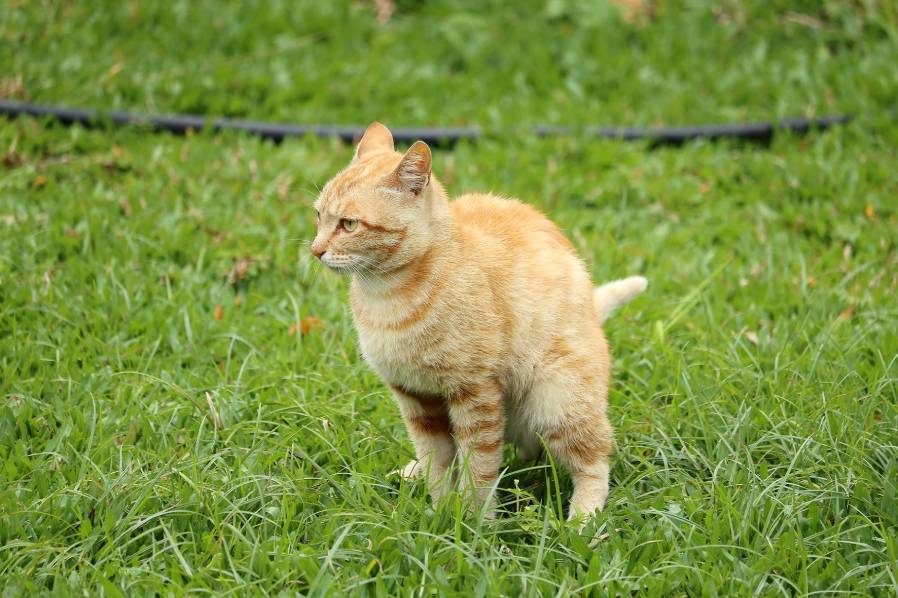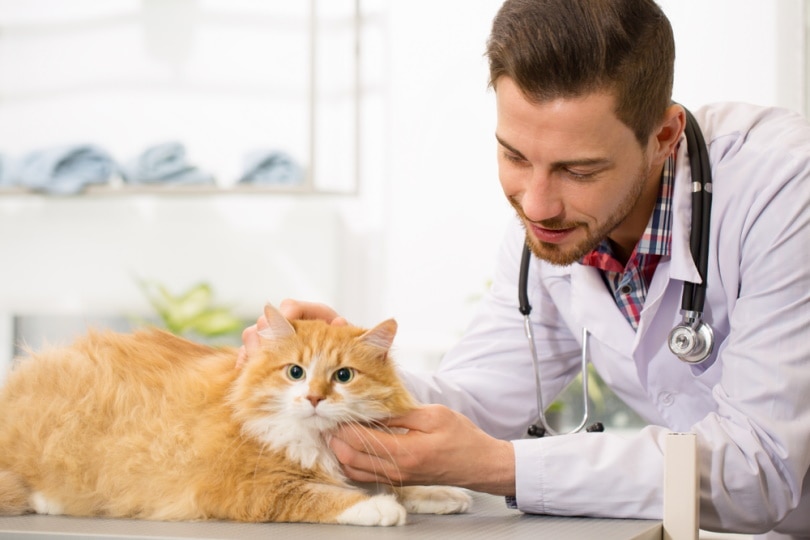Manx Syndrome in Cats (Vet Diagnosis & Management Tips)
Updated on

The Manx cat is considered one of the oldest cats in the world. Legend has it that this cat breed originated hundreds of years ago in the Isle of Man, located off the coast of England. The Manx cat is a chatty creature that loves to be around its humans. These cats will follow you around and may even help you type on a keyboard. They love chasing feather wands, and they get along well with dogs and other cats.
This cat breed also has a unique feature: most have little to no tail. While this looks cute and unique, some Manx cats deal with Manx Syndrome. If you’ve never heard of this syndrome, stick around to learn what it is and what treatments are available.
What Is Manx Syndrome?
Manx Syndrome1 comes from an inherited mutant gene in the Manx cat breed that causes a few health issues in Manx cats with the condition. Not all Manx cats develop the condition, but it’s common among this cat breed, and all Manx cats carry the mutant gene.
Manx Syndrome affects the function of the hind legs, bladder, and colon. It is not exclusive to Manx cats, as other tailless breeds can have the condition.

What Are the Signs of Manx Syndrome?
Signs of Manx Syndrome vary and will depend on the abnormality of the spinal cord. They are as follows:
- Constipation
- Urinary and fecal incontinence
- Urinary Tract Infections (UTI)
- Partial paralysis of the hind legs
- Rectal prolapse
- Bunny hopping gait
- No feeling around the anal area
- Arthritis
- Megacolon
Most signs are visible due to the characteristics of the breed, and some believe it’s even unethical to breed these cats due to the possibility of having the syndrome. As we’ve stated, not all Manx cats will develop Manx Syndrome, but keep in mind that all Manx cats carry the mutant gene that causes the syndrome.

What Are the Causes of Manx Syndrome?
This syndrome is caused by the last few vertebrae in the spine and the spinal segments developing abnormally, also known as spina bifida. While Manx Syndrome is common in Manx cats, other tailless cat breeds can develop the condition, and most cats born as tailless cats suffer neurological problems because of the shortened tail or lack thereof.
Manx Syndrome is inherited through an autosomal dominant trait, but the severity of spinal malformation varies in cats with the condition. All Manx cats carry the mutant gene that can be passed on to the offspring, but again, not all Manx cats develop Manx Syndrome. Kittens with a severe form of the condition usually die before being born or are humanely euthanized shortly afterward. Kittens with a lesser severity begin to show signs a few weeks after birth.
If you’re searching for a Manx cat, ensure the breeder is reputable. While it’s impossible to prevent Manx Syndrome, reputable breeders are well aware of the condition and try to avoid the offspring developing it. For instance, if a no-tail Manx (“rumpy”) is bred with a short-tailed Manx (“stumpy”), the offspring has more of a chance of being healthy.
Reputable breeders will also keep kittens for at least 4 months to watch for signs of Manx Syndrome before adopting them out to new homes. Reputable breeders will also not breed any cat that already has the syndrome.

What Treatments Are Available for Manx Syndrome?
Unfortunately, there is no cure for Manx Syndrome, but it’s possible to treat and manage the complications associated with the conditions to reduce the negative impacts it has on cats living with the syndrome. Urinary tract infections are common with the syndrome, which makes the cat having to wear incontinence diapers a strong possibility.
A cat with Manx Syndrome will need the fur and skin cleaned daily, as cats with the syndrome often lose control of their bladder and bowels. If left uncleaned, chronic irritation can occur, which could lead to infections. A Manx cat with the syndrome may need to have the bladder manually emptied to prevent bladder infections and urine scald. Your veterinarian can show you how to perform this procedure. Stool softeners can be effective in treating constipation.
Physical therapy may be an option for cats with Manx Syndrome, but you’ll need to consult your veterinarian before trying any form of therapy, as it may do more harm than good.
Frequently Asked Questions (FAQs)

How Is Manx Syndrome Diagnosed?
Your veterinarian will do a complete and thorough examination of your cat before making a diagnosis. Most likely, radiographs and other imaging tests, such as magnetic resonance imaging (MRI), will be performed to determine spine defects. A urinalysis and neurological exam will also be necessary to make a diagnosis. A bacterial culture may also be done to determine if a urinary tract infection is present.
How Long Do Cats Live With Manx Syndrome?
Some good news is Manx cats living with Manx Syndrome can live an average of 10 to 14 years. Every Manx cat is different, and this number could vary. However, a Manx cat with severe Manx Syndrome is usually humanely euthanized.
Given that the condition is treatable and if it is not a severe form, the lifespan can be the same as a cat without the condition as long as it’s managed. If you have a cat diagnosed, it’s important to work with your veterinarian for treatment plans.
In Conclusion
Manx Syndrome is common in Manx cats, but keep in mind that not all Manx cats have the condition. A cat with Manx Syndrome can live a relatively normal life with managing techniques, but you must adhere to your veterinarian’s treatment plans.
Manx cats are easygoing and love humans, but if you adopt one with the condition, be sure everyone in the home knows how to care for the cat and to be gentle when interacting with the cat, especially when picking the cat up. Give the cat lots of love, and you’ll get lots of love in return.
Featured Image Credit: Cheryl Kunde, Shutterstock











